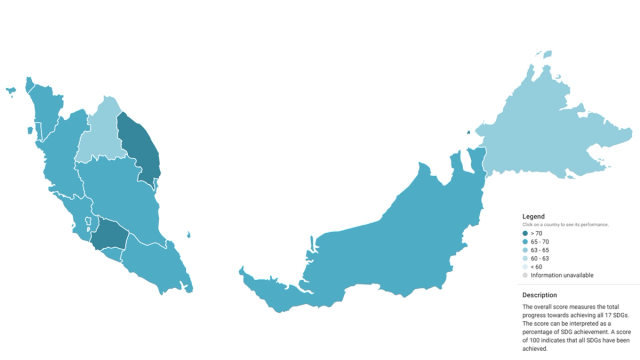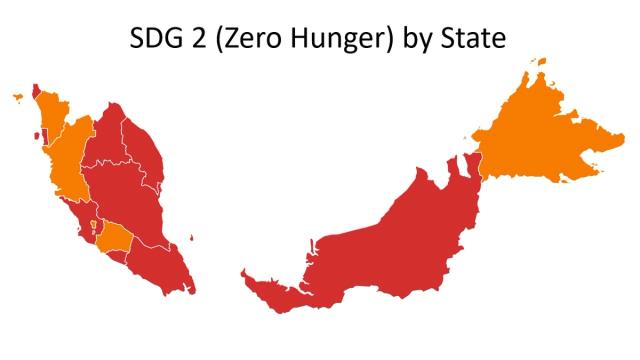SDSN Launches New Dashboard Tracking SDG Progress Across Malaysian States
On April 1, 2025, the UN Sustainable Development Solutions Network (SDSN) and the Jeffrey Sachs Center on Sustainable Development at Sunway University launched the 2025 edition of the “SDGs for Malaysian States,” an interactive dashboard with updated data from 2022. The dashboard’s data highlights the unevenness of Sustainable Development Goals (SDGs) progress across Malaysian states and pushes state-level actors to localize and address those challenges.
Overall, Malaysia’s SDG performance by states is stagnant. Across the 15 states and federal territories and the 15 SDGs assessed, there were only 73 instances where progress was on track to meet a Goal by 2030. In contrast, 81 instances showed improvement, but not at a pace fast enough to reach the target. The assessment also found 55 cases of slow or no progress, and 12 cases of decline.
East Malaysia, Kelantan, and Perlis are ranked as the bottom four, reflecting the historical unevenness of development in those areas. Yet, the wealth of states like Kuala Lumpur, Penang, and Selangor did not translate into higher assessment scores, given the SDGs’ more holistic assessment of development.
Overall SDG progress across Malaysian states (A score of 100 indicates that all SDGs have been achieved)
Malaysia’s Achievements & Challenges
Overall, Malaysia excels at supplying basic needs like “Clean Water and Sanitation” (SDG 6) and “Affordable and Clean Energy” (SDG 7) to the vast majority of its population. However, the northern state of Kelantan struggles to provide clean drinking water, while the southern state of Johor has the lowest proportion of river basins that have good water quality at 72% (the national average is 95.2%).
Most Malaysian states have performed well regarding “Decent Work and Economic Growth” (SDG 8). Indicators for this goal include the annual growth rate of real GDP per capita, the employment-to-population ratio, the frequency of fatal occupational injuries, the unemployment rate, and the proportion of informal employment within the total workforce. Many states have also shown consistent improvements and are on track to meet the targets by 2030.
The weakest performance was observed in SDG 2 (Zero Hunger), SDG 5 (Gender Equality), and SDG 17 (Partnerships for the Goals). For SDG 2, key challenges include high rates of wasting, stunting, and obesity in children under five. SDG 5 performance lags primarily due to the low representation of women in leadership positions. SDG 17 faces setbacks due to uneven fixed broadband Internet coverage across states.
While Malaysia performs well on international poverty metrics (SDG 1), many states fall short on national indicators, such as the population living in absolute and relative poverty. On SDG 10 (Reduced Inequalities), which is assessed using the GINI coefficient and Palma ratio, only a few states—including Labuan, Pahang, and Selangor—are on track to meet the goal. Others, such as Kedah, Kuala Lumpur, and Kelantan, are trending in the opposite direction.
The Path to Achieving the SDGs
Successive Malaysian administrations have demonstrated a commitment to advancing the SDGs through SDG indicator mapping initiatives, the submission of Voluntary National Reviews, and the launch of the SDG Roadmap for Malaysia Phase II 2021 – 2025. However, despite these national-level efforts, much more must be done to ensure that all sectors of society are meaningfully engaged in localizing the SDGs.
Our updated dashboard assesses 72 indicators, yet the need for more disaggregated, state-level data remains urgent. Without it, monitoring progress and identifying areas for improvement becomes challenging. For example, due to a lack of available state-level data, SDGs 12 (Responsible Consumption and Production) and 13 (Climate Action) could not be assessed, limiting the ability to present a comprehensive picture of SDG performance.
Key indicators like SDG 7 (Renewable energy share in total final energy consumption & CO₂ emissions from fuel combustion per total electricity output), SDG 11 (Population with convenient access to public transport in cities), SDG 13 (GHG emissions embodied in imports & CO₂ emissions embodied in fossil fuel exports) and SDG 17 (Government spending on health and education) are critically unavailable. In addition to these data gaps, many Malaysians — especially in rural areas — face stark inequalities in basic services. In some communities and schools, water infrastructure may exist, but pipes often run dry for days at a time, revealing the gap between access and actual availability.

